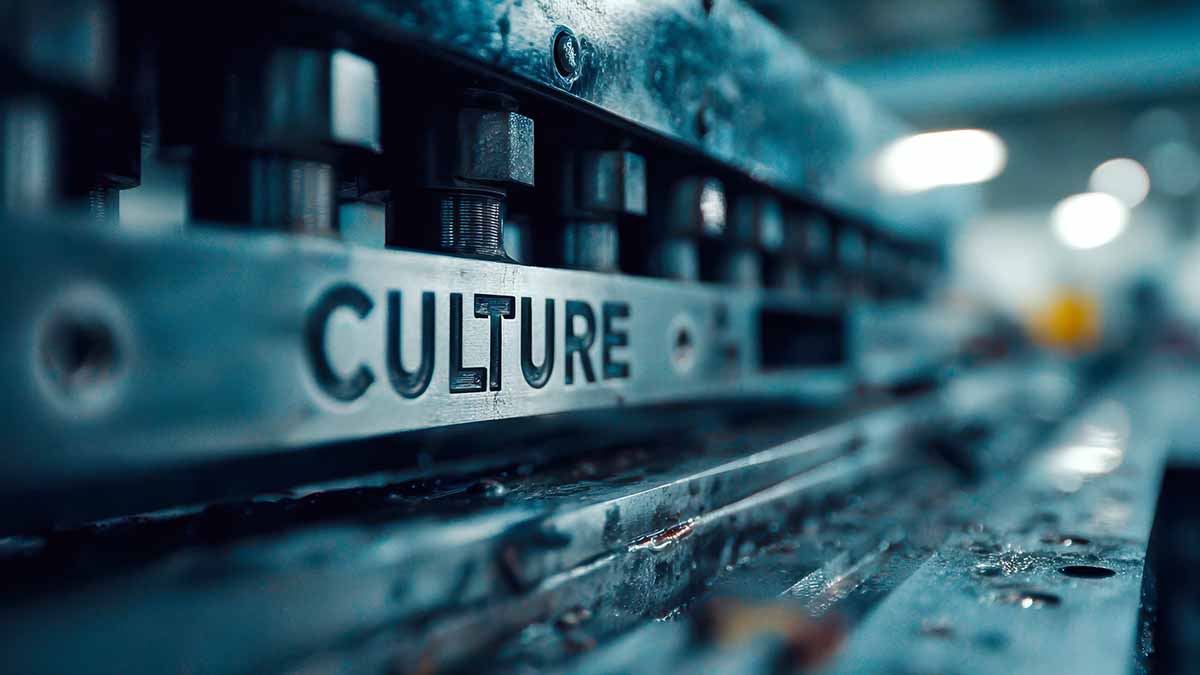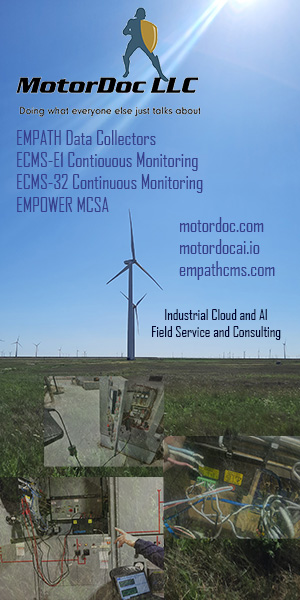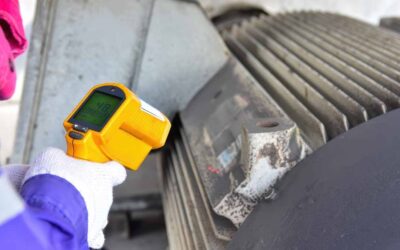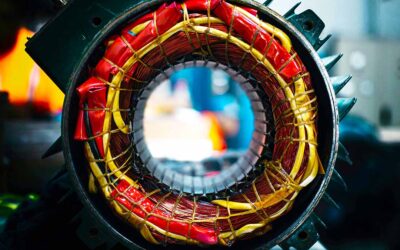Culture is a powerful yet often overlooked critical success factor in asset management. A strong and positive organizational culture can significantly influence asset management’s effectiveness and enable an environment where continuous improvement and reliability are prioritized.
Cultivating the asset management culture by aligning organizational values and behaviors can lead to better outcomes and long-term benefits.
Culture isn’t just a backdrop – it’s a driver of proactive, high-impact asset management.
Reliability professionals and asset managers are well placed to support this organizational focus by encouraging a proactive approach, emphasizing preventive activities, over-reactive repairs, and a holistic view of the asset lifecycle.
What is Organizational Culture?
Organizational culture is defined by shared values, beliefs, and behaviors that shape how work gets done within an organization. In asset management, culture influences how teams work together and approach innovation, risk management, collaboration, and decisions.
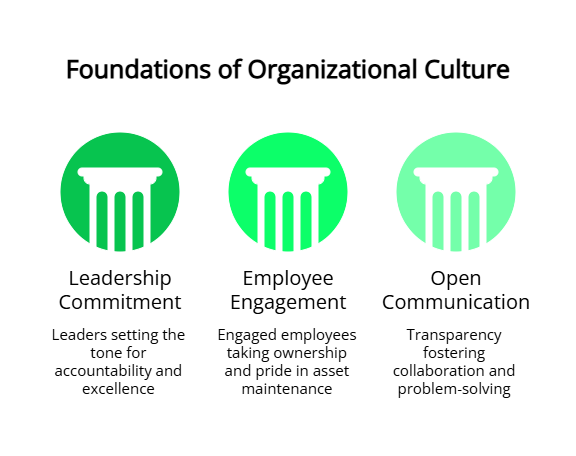
The GFMAM Asset Management Landscape defines asset management as ‘the coordinated efforts of the organization to deliver value from assets.’ An organizational culture focusing on reliability, continuous improvement, and operational excellence can lead to more proactive and effective maintenance practices, reducing downtime, increasing availability and throughput, and extending asset life.
Key Elements
- Leadership commitment – Leadership sets the tone for driving a culture of accountability and excellence
- Employee engagement – Engaged employees are more likely to take ownership and pride in maintaining assets. They will notice changes in asset performance – both positive and negative – and try to address any opportunities or threats.
- Open communication – a culture of transparency encourages better collaboration between and across different teams with an overall focus on problem-solving, sustainability, and continuous improvement
Leadership’s Role in Shaping Culture
Leadership is pivotal in shaping and reinforcing a positive asset management culture. Leaders demonstrate their commitment to reliability, continuous improvement, safety, and environmental stewardship by setting clear expectations, providing the necessary resources, and leading by example.
This includes following governance and assurance practices, making data-driven decisions, supporting ongoing training to enable employees to stay current and up-to-date, and recognizing employees’ contributions to asset performance.
Leading Practices to Shape Culture
- Lead by example – Leadership models both the behaviors and attitudes that they want to see in their teams
- Invest in training – provide ongoing educational and development opportunities focused on asset management, reliability, and maintenance management. The adage ‘What if we train them and they leave?’ and its corollary ‘What if we don’t and they stay?’ comes to mind
- Celebrate success – recognize and reward teams and individuals contributing to improved asset reliability and cross-functional collaboration.
Encourage a Proactive Approach
A strong asset management culture emphasizes the positive outcomes from proactive and preventive activities over-reactive repairs. This mindset shifts in the maintenance and reliability teams and the way they are rewarded.
It requires an investment in developing and implementing proactive maintenance strategies, fostering team collaboration, and encouraging employees to identify potential or emerging issues before they escalate into major equipment failures.
Empowering employees to take the initiative to act on observations and creating a culture that supports this can lead to significant improvement in both asset lifespan and performance.
Maintenance Management Professionals are responsible for overseeing and improving maintenance operations within an organization. Reliability Management Professionals are more focused on tomorrow’s future, meeting future needs with minimum failures and reducing the total cost of ownership.
Asset Management focuses on how the present, past, and future lifecycle activities are coordinated to realize value from assets. All three functional roles – Maintenance, Reliability, and Asset Management professionals – contribute to establishing and sustaining a culture that values a holistic and proactive approach.
Leading Practices
- Collaborative problem-solving – encourage cross-functional teams to work together on identifying and resolving issues using methodologies like root cause analysis (RCA) and reliability-centered maintenance (RCM)
- Employee empowerment and engagement – encourage employees to take ownership of their roles and make decisions that impact asset reliability. Ensure that employees are informed of the organizational direction to make balanced decisions considering cost, risk, performance, and the impact on value.
- Proactive maintenance strategies – encourage the use of holistic practices to establish maintenance strategies and asset health monitoring to predict and prevent failures before they occur.
Establish a Culture of Continuous Improvement
Continuous improvement is at the heart of any effective asset management strategy and the resultant culture – it is more than mere compliance with standards.
From a maintenance and reliability professional perspective, this includes regularly assessing maintenance and reliability practices and processes, objectively measuring asset and equipment performance, learning from failures, and implementing changes that can drive better results.
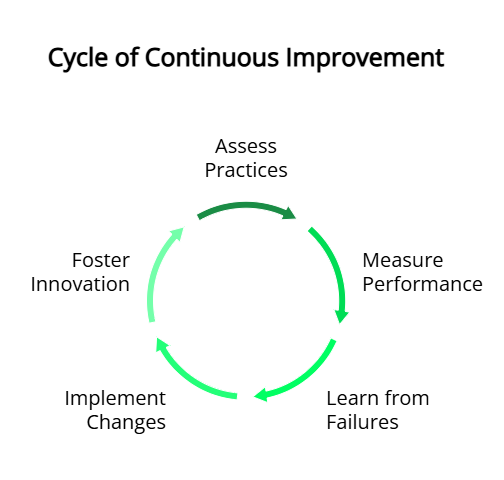
Cultivating a culture of continuous improvement requires establishing a work environment where employees feel safe to suggest improvements, experiment, innovate, and learn from successes and setbacks.
Leading Practices
- Periodic assessments – conduct objective assessments of maintenance and reliability practices and processes against benchmarks and maturity scales to highlight areas for improvement. This may include year-over-year performance for the same production plant, a sister site, or against a well-established third-party maturity scale.
- Learn from setbacks – Treat failures as learning opportunities and encourage open discussions about what went wrong to promote continuous improvement. This concept of ‘fail forward’ is widely attributed to John Maxwell, who said, ‘Fail early, fail often, but always fail forward.’
- Innovation – promote a culture where employees are empowered to make suggestions and have a clear process whereby innovative solutions can be evaluated, and if approved, then implemented. While not every idea needs to be implemented, there should be a relative threshold of projects and innovative initiatives that do proceed and are supported by Leadership.
Fostering a Sustainability and Safety-Oriented Culture
Sustainability, governance, and safety are critical components and enablers of asset management and the associated culture. A culture that prioritizes sustainability and governance is one that considers the long-term impact of today’s decisions on asset longevity and protecting the environment.
A safety-oriented culture ensures that all workers on our sites are committed to maintaining a safe work environment. This, in turn, reduces or ideally eliminates both personal and process safety incidents while protecting people and physical assets and, in turn, enhancing reliability.
A strong adherence and commitment to assurance, governance, and safety protocols is interconnected with our shared responsibility for identifying and mitigating risks.
Leading Practices
- Sustainability – A focus on the long-term impact of both design phase and operational decisions on asset longevity and protecting the environment. We have moved past the only end-of-life solution as disposal to one where reclamation, repurposing, circular economy, and sale to another producer are the first solutions that come to mind when considering asset retirement obligations (ARO).
- Personal Safety – Provide comprehensive training programs focused on personal safety best practices and role model the expectation that employees follow them.
- Process safety – Implementation of protocols, processes, and procedures to identify and mitigate process safety hazards. This is an area where reliability professionals can have a significant influence through asset criticality assessments, risk considerations when performing failure modes effects criticality analysis (FMECA) or reliability-centered maintenance (RCM) analysis, and implementing asset integrity programs for static pressurized assets.
- Shared responsibility – the collaborative nature of asset management approaches, and the emphasis on coordinated activities enables and encourages all employees to take responsibility for a sustainable and safety-oriented culture that creates value by balancing cost, risk, and performance.
Measuring the Cultural Impact
No different than any other organizational activity, it is important to ensure that initiatives related to an asset management culture deliver the desired outcomes. The most common ways to measure the effectiveness of these cultural initiatives are through assessments and performance metrics.
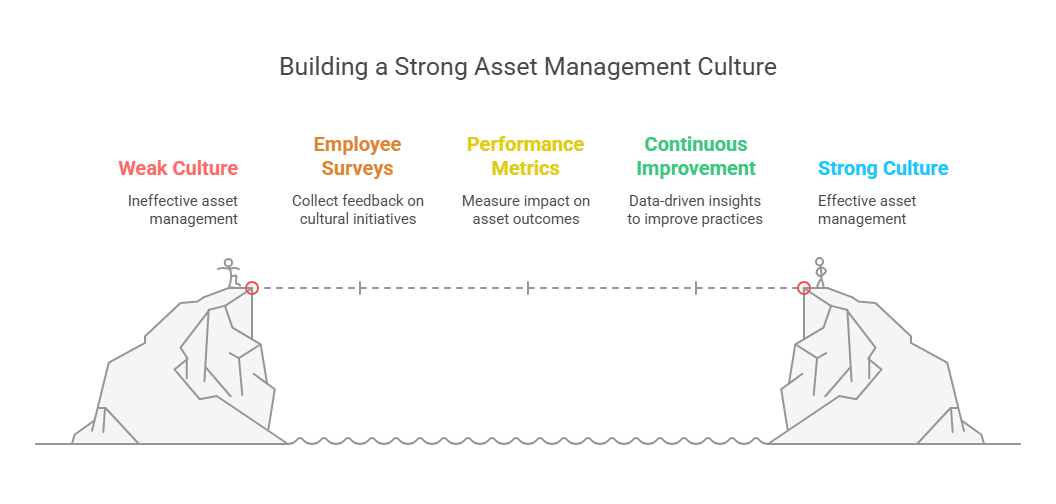
Organizations can refine their approaches by tracking progress and making data-driven adjustments to encourage a positive asset management culture.
Leading Practices
- Employee surveys – Collect feedback from employees on cultural initiatives and their effectiveness regularly.
- Performance metrics – Use of performance measures by department, by project or by process can be used to measure the impact of cultural initiatives on asset management outcomes. These departmental performance measures, in turn, roll up to the overall organizational key performance indicators (KPIs). Comparison against asset management maturity scales may also be helpful for objectively measuring progress. The Global Forum on Maintenance and Asset Management (GFMAM.org) has several guidelines for AM assessors and maturity assessments that are freely available.
- Continuous improvement – No initiative gets everything right the first time. The familiar plan-do-check-act (PDCA) cycle encourages us to use data-driven insights to improve and upgrade our asset management, reliability, and maintenance practices, fostering an improved asset management culture.
From Strategy to Reality: Culture Makes It Work
In our pursuit of asset management excellence, culture is a fundamental enabler of success. For reliability professionals and asset managers, building and sustaining a strong and positive culture that encourages a proactive approach to maintenance and reliability, continuous improvement, operational excellence, and sustainability can significantly improve asset reliability and overall performance.
A prioritization of leadership commitment, employee engagement and empowerment, and open communications creates an environment where assets are well maintained, risks are considered and appropriately mitigated, and long-term value is maximized.

